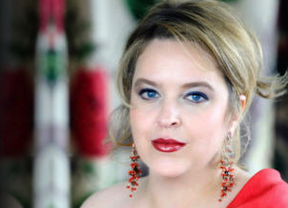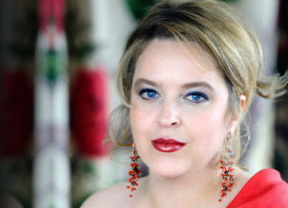
For Baroque music lovers, the name Karina Gauvin rings like gold. The Canadian soprano has recently completed a European tour and a much-lauded recording of Handel’s Ariodante for EMI Virgin Classics, plus another tour and recording of his Giulio Cesare for Naïve, both with Alan Curtis conducting Il Complesso Barocco. But even after you figure in recent solos in Bach’s Johannes Passion with Les Violons du Roy and Bernard Labadie in Carnegie Hall, Vivaldi’s Gloria with the Swedish Radio Choir, and multiple appearances and recordings with the Boston Early Music Festival, you have only a partial picture of her artistry.
The San Francisco Symphony under Michael Tilson Thomas has welcomed Gauvin twice, for performances of Debussy’s Martyrdom of Saint Sebastian and Mahler’s Symphony No. 2, and the Rotterdam Philharmonic and Yannick Nézet-Séguin invited her to sing the role of the Princess in Ravel’s L’Enfant et les sortileges. Add in recordings of Britten, Barber, and Canteloube, as well as French song (with Marc-André Hamelin), and you begin to realize the scope of this soprano’s versatility.
At last, on Oct. 13, the Greater Bay Area has the opportunity to hear Gauvin in the French song repertoire for which she’s prized. Accompanied by Michael McMahon, Gauvin’s recital in the vocal-friendly acoustic of Santa Rosa’s just-opened Weill Hall promises to be one of the highlights of the vocal season.
What on your French recital CD with Marc-André Hamelin, Fête galante, will you sing in Sonoma County?
Arthur Honegger’s beautiful six-song cycle, Saluste du Bartas. It’s a story about Marguerite de Valois and her charming relationship. It’s a kind of gallant cycle, quite melodic and very easy to access. Many people are quite taken by it, and I think it’s particularly suited to my voice. I don’t think people should be afraid of it, even though it’s more contemporary.
When you say that the Honegger is particularly suited to your voice, I wonder what you mean?
I’ve always loved French art song, and, of course, it’s my mother tongue. It’s funny. A couple of years back, I had the pleasure of giving a French song recital in Paris at l’Opéra-Comique. That’s where I learned that, for some reason, the French tend to shy away from their own composers. It’s quite sad, because there are wonderful gems in the repertoire. French is not an easy language to sing — it’s very persnickety, if I can use that word — and there are so many elements in the language itself that are very demanding.
The big epoch of French writing began in Wagnerian times and extended into the 20th century. Some of the repertoire requires quite a lot of sound. Singing Bizet is like singing opera arias. But I’ve always chosen things that I feel close to, either melodically or textually. When I’m totally enraptured by the melodies and what the song is talking about, I have so much more to communicate to the public. I have to be very convinced by what I’m doing, and I choose my programs carefully.
Your brand-new recital disc for ATMA Classique, Karina Gauvin: Prima Donna, is mainly devoted to lesser-known Handel arias. I gasped when I heard your “Care selve” from Atalanta, because it’s so different, both orchestrally and vocally, than the version Leontyne Price recorded in 1965 on one of her first two Prima Donna albums. Is Alexander Weimann, who is conducting Arion Orchestre Baroque, conducting Handel’s orchestration?
Yes. It’s very simple. There shouldn’t be all those violins. It’s just basso continuo. Of course, the harpsichordist is enriching it, because Handel didn’t write everything out, but the basis is there. It’s the real thing, without all that extra stuff you hear on Kiri Te Kanawa’s version.
There’s a channel going between the audience and me, an exchange that enables me to have a rapport with them.
And Handel would have expected his divas to add ornamentation such as the trills and variations that you include?
Yes. At his time, embellishments were part of a singer’s responsibility, especially in the da capi [the recapitulation of the original melody]. Mind you, Handel was not too keen on singers doing too much to his music. For him, less was more. But it was the tradition of the period to embellish. Some singers, of course, were more agile, or had more interesting things to add.
Do you work with other people on your embellishments, or write them out beforehand?
You know what? I try to improvise as much as I can. I try not to write them down, unless I’m particularly pleased with them, because then I’ll tend to stick to them. Instead, I’ll keep twiddling with something, working on it as I go along. The tradition was to improvise, not repeat the same thing over and over.
On this recording, the embellishments were my responsibility. Sometimes I work with conductors who like to put their own hand to things. Even then, sometimes it’s a discussion, which I prefer. I don’t like a conductor who says, “This is what you have to sing.” Alan Curtis, who is a musicologist and has a deep knowledge of this repertoire, especially Handel, likes to write his own ornaments, for example — I guess it’s an issue of uniformity — but he invites us to submit our proposals. I work with him a lot, and it’s a real exchange.
The woman who encouraged you to move ahead with a vocal career was Nicole Paiement, who is now in San Francisco teaching at the Conservatory and conducting Ensemble Parallèle.
Yes. What happened, way back, is that I saw they were doing Purcell’s Come Ye, Sons of Art at McGill University. I just love Purcell, so, even though I was studying art history, not music, I decided to audition. Nicole was the conductor, and gave me the soprano part. I guess her decision was not very popular with the voice students, but there you have it.
Life is an ongoing journey. You either decide to learn from it or not.
Nicole told me, “You really need to be a singer.” I took her advice to heart, found a wonderful teacher at the Montreal Conservatoire, and did all my studies there. So I have Nicole to thank.
Let’s talk about your other repertoire for the Green Music Center.
I wanted to include two composers who have anniversaries this year: Massenet, who died 100 years ago, and Debussy, who was born 150 years ago. It’s music I love to sing.
You never hear Massenet, actually. His music is often sung by baritones, but I think his mélodies work quite well for soprano. The music has the flavor of the 19th century, it’s gorgeous, and it’s in the same spirit as the four Duparc songs — “Chanson triste,” “Phidylé,” “Soupir, and “L’Invitation au voyage” — that I’m performing.
For Debussy, I’m doing “Nuit d’Étoiles,” “Mandoline,” “Beau Soir,” and “Noël des Enfants qui n’ont plus de maisons.” That last one is a great song, very intense, about children who have lost their homes due to the war. It’s fantastic.
I’m also finishing the program with an assortment of Bizet songs. “Les Adieux de l’hôtesse arabe” is probably the most famous.
And you’re not doing Delibes’ “Les Filles de Cadix”?
What a great idea! Maybe I’ll do it as an encore.
Debussy sounds radically different when sung by your contemporary, Sandrine Piau, than on the recordings of one of the women who studied with him, Maggie Tayte? How do you tend to approach Debussy’s music?
I’ve always tried to sing from the heart, because for me, that’s the most important place where you have to start.
We hear Maggie Teyte nowadays, and we say, “My goodness, that’s a lot!” It makes me wonder how much of what she did was reflective of the time period, because popular singers such as Yvonne Printemps also did her buttery, downward glissando type of thing. I also wonder how much was requested by the composer, because she worked with Debussy directly. But Debussy wrote everything he wanted, very precisely, in his score, and that’s true of French composers in general.
Now it’s the 21st century. When I sing Debussy, I have to bask myself in that period, but I can’t say that I’m not influenced by the interpretive practice of my own era.
In the end, I have to put all that aside in live performance. I try to go with my heart. After I’ve done all the work and study, I come to the concert hall and say, “OK, the slate is clean now. You, my audience, are in front of me, and I’m here to give you something.”
It will be different each time, and I will be receiving a lot from the audience. Some audiences are more communicative than others. In a recital setting, it’s a real exchange. It can even be quite a private moment with the audience. All that energy gets poured into the pot, and influences the interpretation. I take in the eyes, the smiles, and the tears, as well as the people who don’t show as much but feel just as intently. There’s a channel going between us, an exchange that enables me to have a rapport with them. Recitals are the medium with the most feeling, because it’s really one-on-one the entire evening.
Have your voice and artistry changed over the years?
I’ve always had clear ideas of what I wanted to sound like, and what I was trying to do with my voice. In my younger years, I couldn’t do all the things I was imagining in my mind. Now I feel I’m at the place where I can use my technique to fully serve my interpretive quest.
My voice has also transformed in the last four years. I went through a lot of quite difficult personal issues — a very difficult divorce that isn’t something I’d wish on anybody — and I think the soul searching I did helped get me to the place where I am now vocally. Life has taught me a lot of things, and many people tell me that they hear that something has opened up in my voice.
Life is an ongoing journey. You either decide to learn from it or not. So I decided to learn from it. It’s enriched me so much, in so many ways, and that reflects in my artistry.
I think I’ve always come from the heart. When I started out in the children’s chorus of the Toronto Opera Company when I was 8 years old, the conductor who auditioned me heard something very special. We’re still in touch, and he tells me that he can still hear the same thing in my voice! But maybe the fact that I’ve gone through these difficult times, and was able to look inside and figure things out, has enabled me to come out anew, even more, and maybe go even further than I could previously.
People are there to receive, and you’re there to give. When I was making my first recordings, this woman once wrote me that when her husband was dying, she heard me on the radio, and it filled her heart with hope. “It was a very difficult time, but your singing kept me going.” So I’ve always tried to sing from the heart, because for me, that’s the most important place where you have to start. But I think my recent experience has enabled me to open up and say new things with what I have.

